Physics: Astronomy and Space Science Report on Telescopes
VerifiedAdded on 2023/03/30
|19
|4090
|355
Report
AI Summary
This report provides an in-depth analysis of various telescope types, including the Wilkinson Microwave Anisotropy Probe (WMAP), James Webb Space Telescope (JWST), and Hubble Space Telescope (HST). It explores the crucial role of parabolic mirrors in light telescopes, detailing their ability to converge light, resolve aberrations, and enhance visibility, while also discussing the use of Newtonian reflectors. Furthermore, the report delves into locating night-time astronomical objects using celestial coordinates such as right ascension (RA) and declination, explaining the impact of Earth's rotation and sidereal day on object positioning. It also highlights the importance of considering the 4-minute difference in Earth's rotation relative to stars for accurate object location.

Physics - Astronomy and Space Science 1
Name:
Course:
Tutor:
Date:
Name:
Course:
Tutor:
Date:
Paraphrase This Document
Need a fresh take? Get an instant paraphrase of this document with our AI Paraphraser
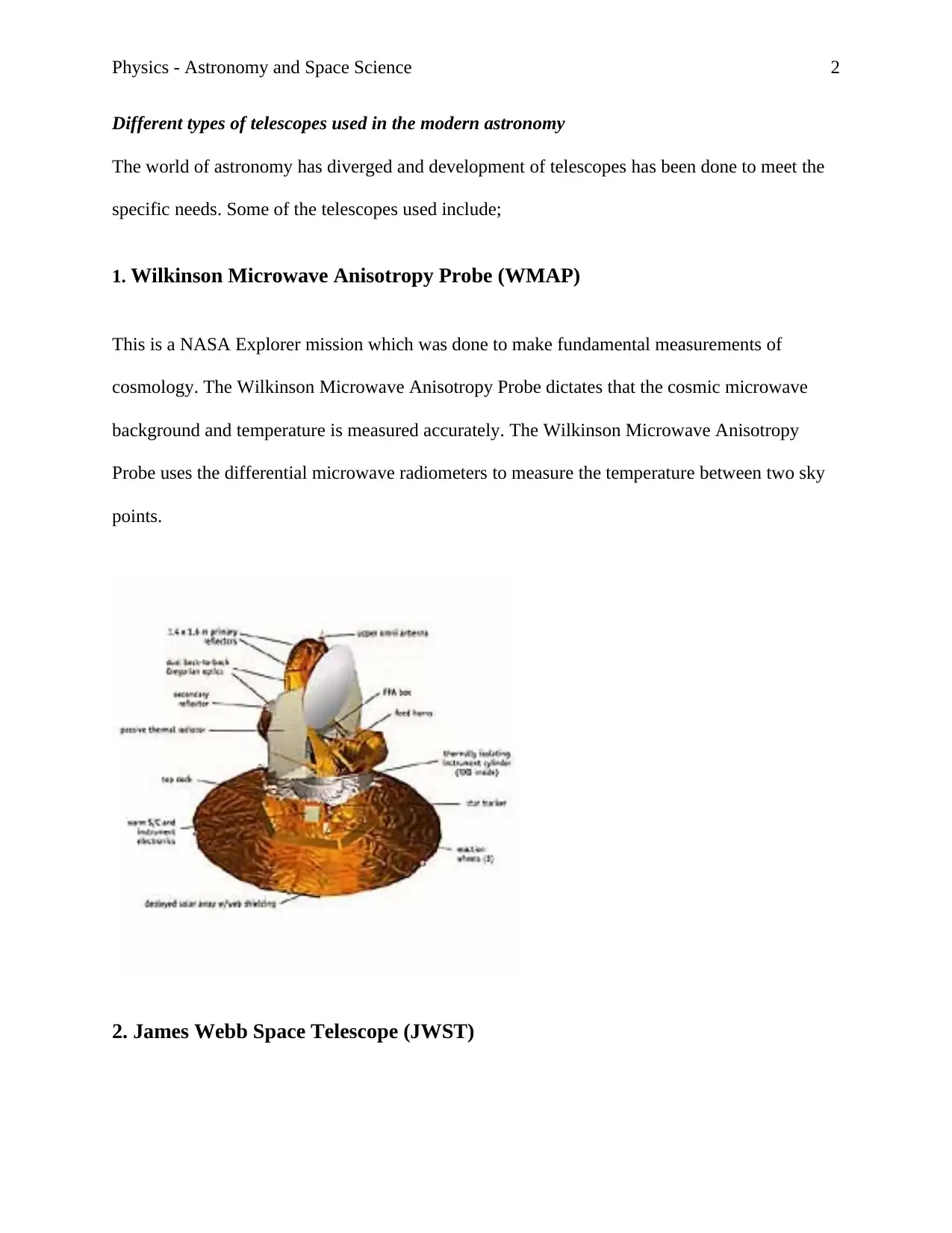
Physics - Astronomy and Space Science 2
Different types of telescopes used in the modern astronomy
The world of astronomy has diverged and development of telescopes has been done to meet the
specific needs. Some of the telescopes used include;
1. Wilkinson Microwave Anisotropy Probe (WMAP)
This is a NASA Explorer mission which was done to make fundamental measurements of
cosmology. The Wilkinson Microwave Anisotropy Probe dictates that the cosmic microwave
background and temperature is measured accurately. The Wilkinson Microwave Anisotropy
Probe uses the differential microwave radiometers to measure the temperature between two sky
points.
2. James Webb Space Telescope (JWST)
Different types of telescopes used in the modern astronomy
The world of astronomy has diverged and development of telescopes has been done to meet the
specific needs. Some of the telescopes used include;
1. Wilkinson Microwave Anisotropy Probe (WMAP)
This is a NASA Explorer mission which was done to make fundamental measurements of
cosmology. The Wilkinson Microwave Anisotropy Probe dictates that the cosmic microwave
background and temperature is measured accurately. The Wilkinson Microwave Anisotropy
Probe uses the differential microwave radiometers to measure the temperature between two sky
points.
2. James Webb Space Telescope (JWST)
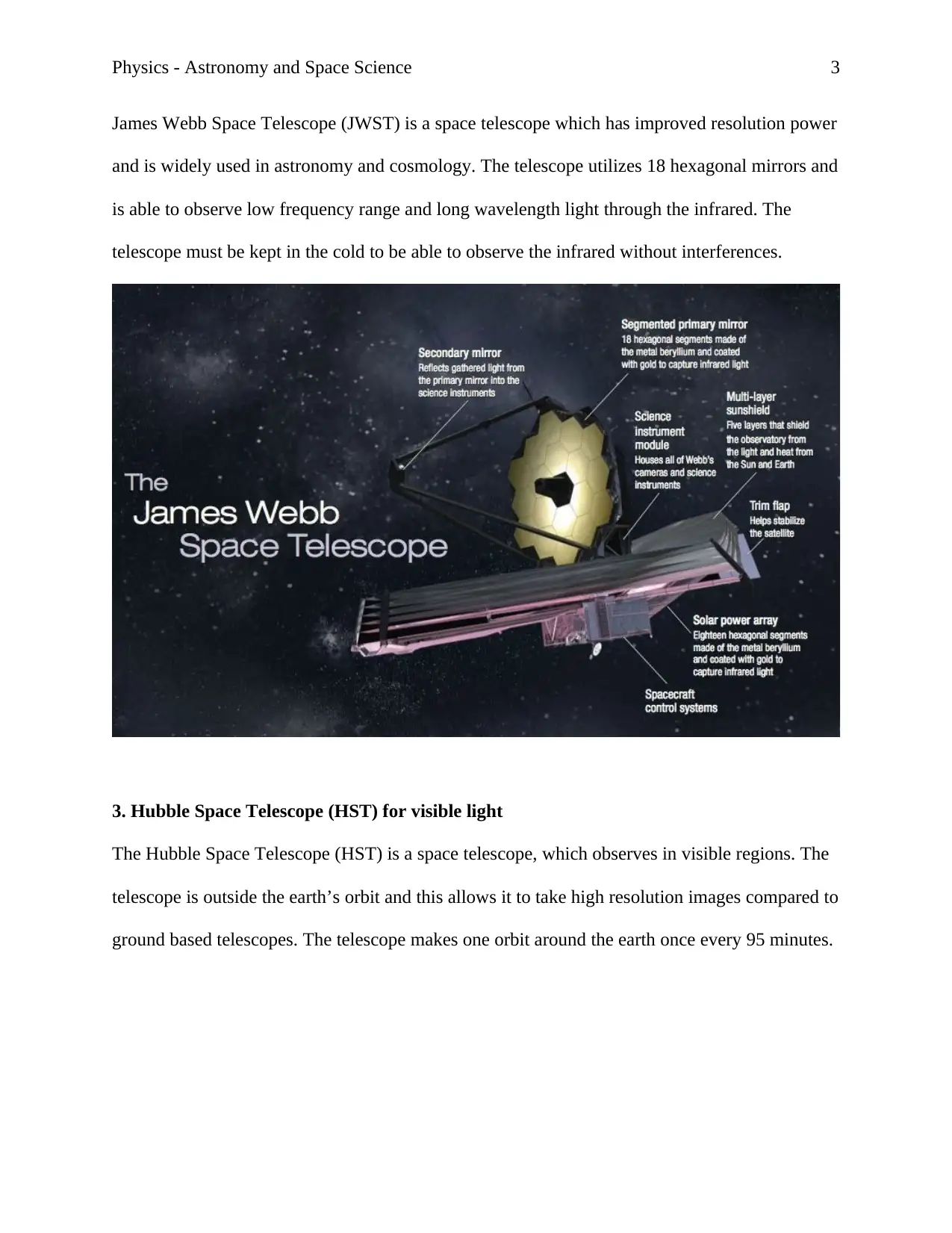
Physics - Astronomy and Space Science 3
James Webb Space Telescope (JWST) is a space telescope which has improved resolution power
and is widely used in astronomy and cosmology. The telescope utilizes 18 hexagonal mirrors and
is able to observe low frequency range and long wavelength light through the infrared. The
telescope must be kept in the cold to be able to observe the infrared without interferences.
3. Hubble Space Telescope (HST) for visible light
The Hubble Space Telescope (HST) is a space telescope, which observes in visible regions. The
telescope is outside the earth’s orbit and this allows it to take high resolution images compared to
ground based telescopes. The telescope makes one orbit around the earth once every 95 minutes.
James Webb Space Telescope (JWST) is a space telescope which has improved resolution power
and is widely used in astronomy and cosmology. The telescope utilizes 18 hexagonal mirrors and
is able to observe low frequency range and long wavelength light through the infrared. The
telescope must be kept in the cold to be able to observe the infrared without interferences.
3. Hubble Space Telescope (HST) for visible light
The Hubble Space Telescope (HST) is a space telescope, which observes in visible regions. The
telescope is outside the earth’s orbit and this allows it to take high resolution images compared to
ground based telescopes. The telescope makes one orbit around the earth once every 95 minutes.
⊘ This is a preview!⊘
Do you want full access?
Subscribe today to unlock all pages.

Trusted by 1+ million students worldwide
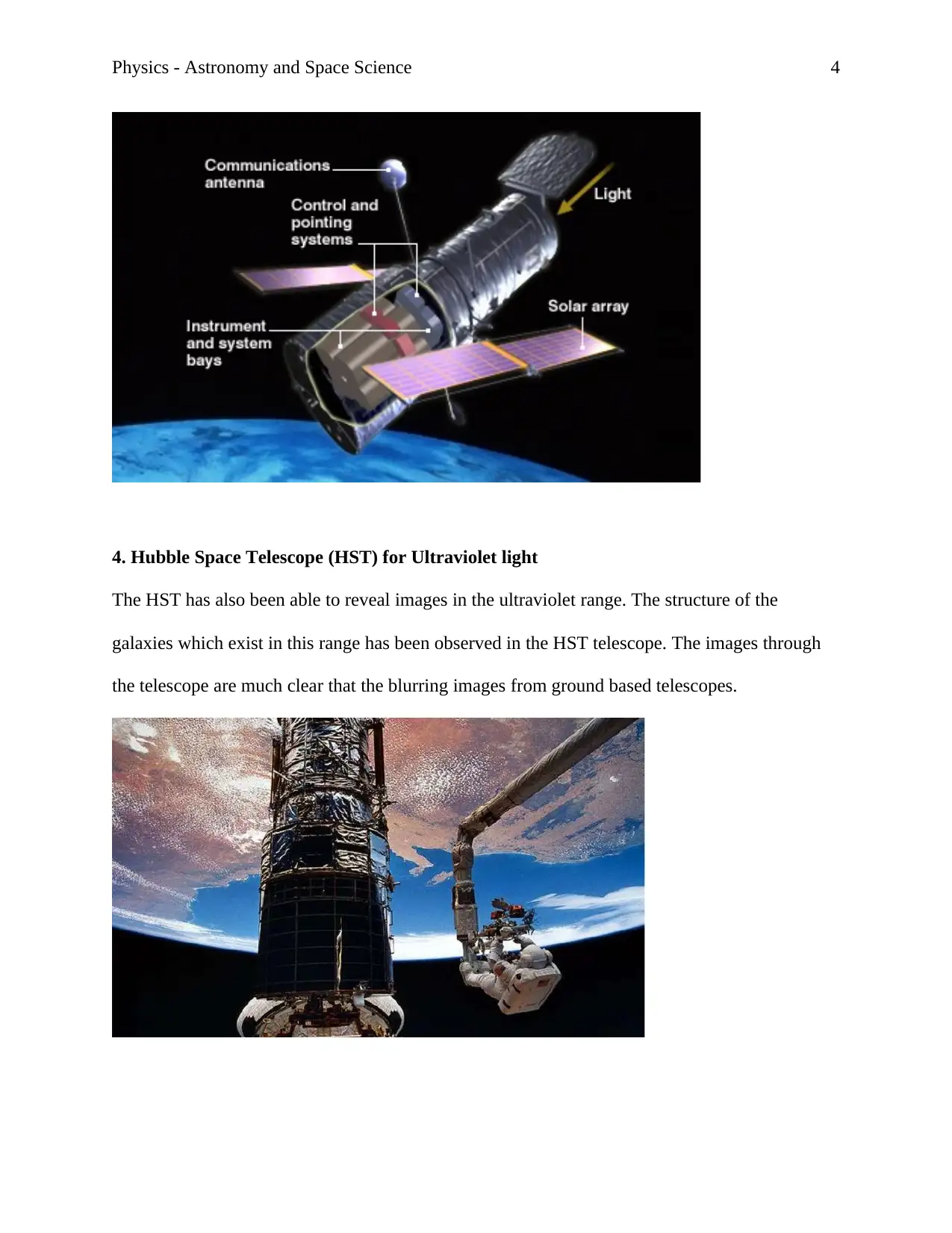
Physics - Astronomy and Space Science 4
4. Hubble Space Telescope (HST) for Ultraviolet light
The HST has also been able to reveal images in the ultraviolet range. The structure of the
galaxies which exist in this range has been observed in the HST telescope. The images through
the telescope are much clear that the blurring images from ground based telescopes.
4. Hubble Space Telescope (HST) for Ultraviolet light
The HST has also been able to reveal images in the ultraviolet range. The structure of the
galaxies which exist in this range has been observed in the HST telescope. The images through
the telescope are much clear that the blurring images from ground based telescopes.
Paraphrase This Document
Need a fresh take? Get an instant paraphrase of this document with our AI Paraphraser

Physics - Astronomy and Space Science 5
5. X-MM Newton
The X-MM Newton was an X-ray telescope designed to diffuse the X-rays background, survey
of the stars and galaxies as well as X-ray emitted gases. The telescope is a space telescope and
used to study celestial X-ray sources.
Section 1: Description of the necessity of parabolic mirrors in light telescopes
Parabolic mirrors bear the shape of a parabola. Their use in light telescope has been
important for several reasons. The first parabolic mirror was made in 1673 which was done by
Robert Hooke by basing on the design done by James Gregory (Woolfson, 2011). According to
Wallace, Defence R&D Canada, & Defence R&D Canada (2015), the parabolic mirrors are
necessary in light telescopes because they are able to collect and focus the light into one focus
point. This is able to give a wider view of the telescopes. The light is collected from a wider
5. X-MM Newton
The X-MM Newton was an X-ray telescope designed to diffuse the X-rays background, survey
of the stars and galaxies as well as X-ray emitted gases. The telescope is a space telescope and
used to study celestial X-ray sources.
Section 1: Description of the necessity of parabolic mirrors in light telescopes
Parabolic mirrors bear the shape of a parabola. Their use in light telescope has been
important for several reasons. The first parabolic mirror was made in 1673 which was done by
Robert Hooke by basing on the design done by James Gregory (Woolfson, 2011). According to
Wallace, Defence R&D Canada, & Defence R&D Canada (2015), the parabolic mirrors are
necessary in light telescopes because they are able to collect and focus the light into one focus
point. This is able to give a wider view of the telescopes. The light is collected from a wider
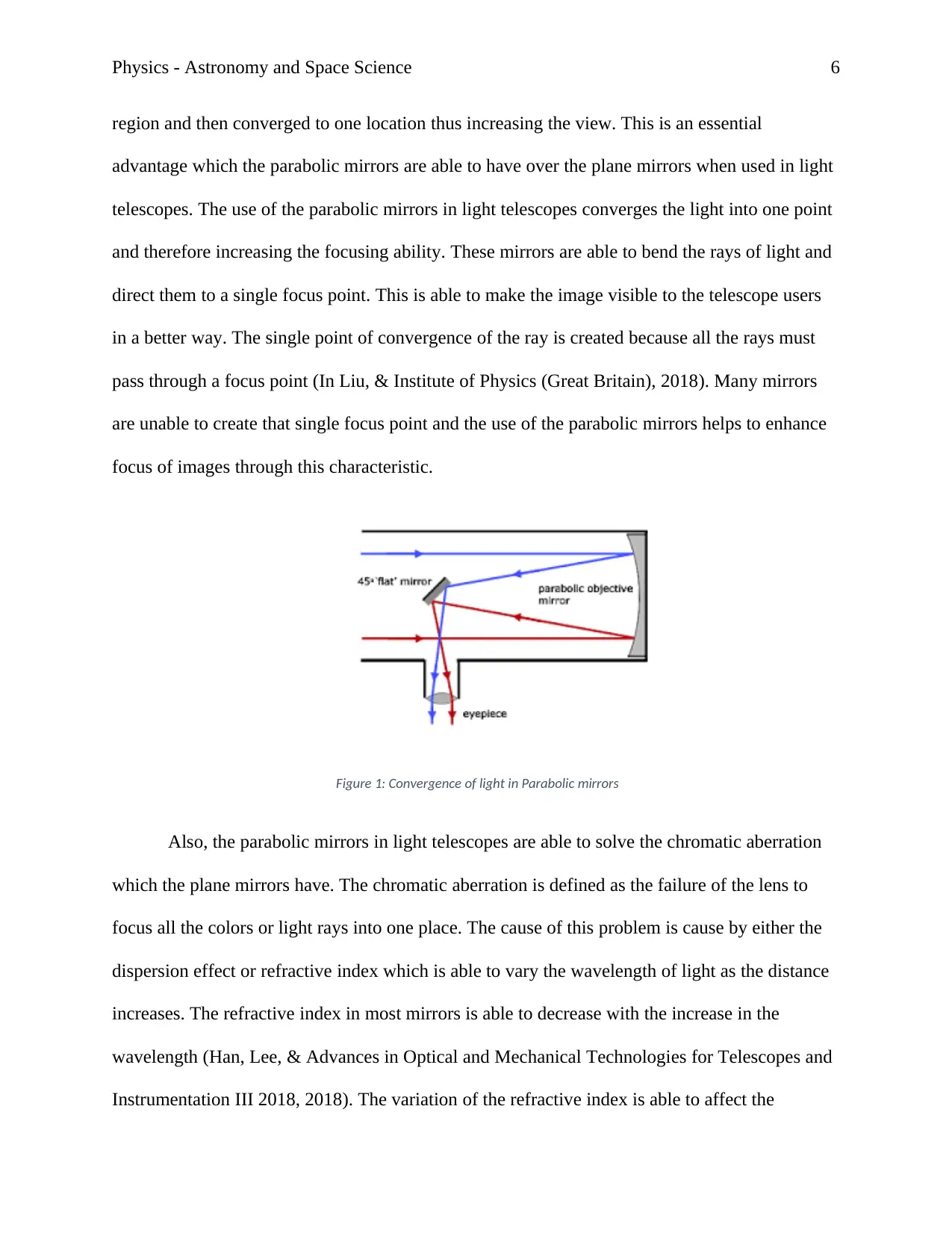
Physics - Astronomy and Space Science 6
region and then converged to one location thus increasing the view. This is an essential
advantage which the parabolic mirrors are able to have over the plane mirrors when used in light
telescopes. The use of the parabolic mirrors in light telescopes converges the light into one point
and therefore increasing the focusing ability. These mirrors are able to bend the rays of light and
direct them to a single focus point. This is able to make the image visible to the telescope users
in a better way. The single point of convergence of the ray is created because all the rays must
pass through a focus point (In Liu, & Institute of Physics (Great Britain), 2018). Many mirrors
are unable to create that single focus point and the use of the parabolic mirrors helps to enhance
focus of images through this characteristic.
Figure 1: Convergence of light in Parabolic mirrors
Also, the parabolic mirrors in light telescopes are able to solve the chromatic aberration
which the plane mirrors have. The chromatic aberration is defined as the failure of the lens to
focus all the colors or light rays into one place. The cause of this problem is cause by either the
dispersion effect or refractive index which is able to vary the wavelength of light as the distance
increases. The refractive index in most mirrors is able to decrease with the increase in the
wavelength (Han, Lee, & Advances in Optical and Mechanical Technologies for Telescopes and
Instrumentation III 2018, 2018). The variation of the refractive index is able to affect the
region and then converged to one location thus increasing the view. This is an essential
advantage which the parabolic mirrors are able to have over the plane mirrors when used in light
telescopes. The use of the parabolic mirrors in light telescopes converges the light into one point
and therefore increasing the focusing ability. These mirrors are able to bend the rays of light and
direct them to a single focus point. This is able to make the image visible to the telescope users
in a better way. The single point of convergence of the ray is created because all the rays must
pass through a focus point (In Liu, & Institute of Physics (Great Britain), 2018). Many mirrors
are unable to create that single focus point and the use of the parabolic mirrors helps to enhance
focus of images through this characteristic.
Figure 1: Convergence of light in Parabolic mirrors
Also, the parabolic mirrors in light telescopes are able to solve the chromatic aberration
which the plane mirrors have. The chromatic aberration is defined as the failure of the lens to
focus all the colors or light rays into one place. The cause of this problem is cause by either the
dispersion effect or refractive index which is able to vary the wavelength of light as the distance
increases. The refractive index in most mirrors is able to decrease with the increase in the
wavelength (Han, Lee, & Advances in Optical and Mechanical Technologies for Telescopes and
Instrumentation III 2018, 2018). The variation of the refractive index is able to affect the
⊘ This is a preview!⊘
Do you want full access?
Subscribe today to unlock all pages.

Trusted by 1+ million students worldwide
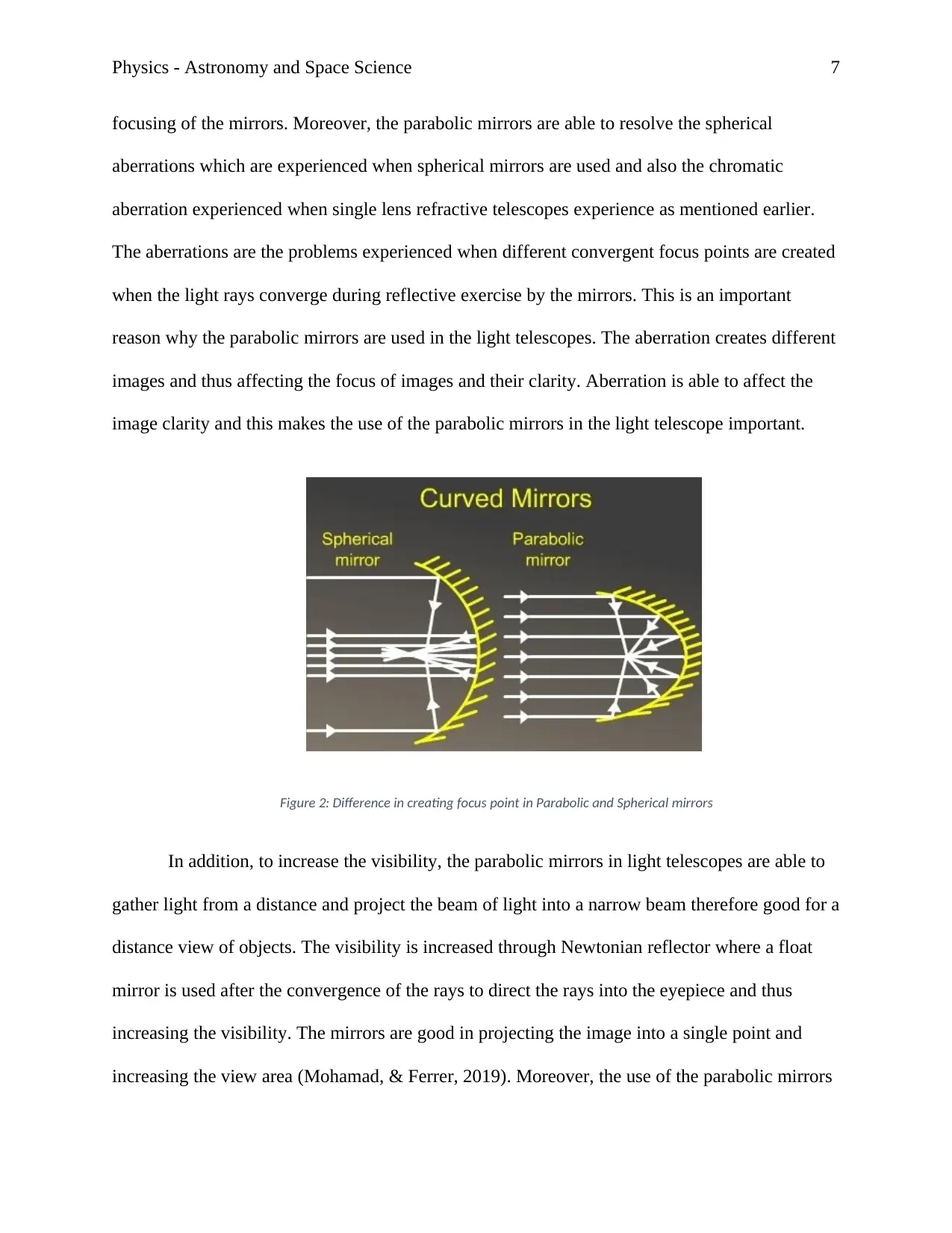
Physics - Astronomy and Space Science 7
focusing of the mirrors. Moreover, the parabolic mirrors are able to resolve the spherical
aberrations which are experienced when spherical mirrors are used and also the chromatic
aberration experienced when single lens refractive telescopes experience as mentioned earlier.
The aberrations are the problems experienced when different convergent focus points are created
when the light rays converge during reflective exercise by the mirrors. This is an important
reason why the parabolic mirrors are used in the light telescopes. The aberration creates different
images and thus affecting the focus of images and their clarity. Aberration is able to affect the
image clarity and this makes the use of the parabolic mirrors in the light telescope important.
Figure 2: Difference in creating focus point in Parabolic and Spherical mirrors
In addition, to increase the visibility, the parabolic mirrors in light telescopes are able to
gather light from a distance and project the beam of light into a narrow beam therefore good for a
distance view of objects. The visibility is increased through Newtonian reflector where a float
mirror is used after the convergence of the rays to direct the rays into the eyepiece and thus
increasing the visibility. The mirrors are good in projecting the image into a single point and
increasing the view area (Mohamad, & Ferrer, 2019). Moreover, the use of the parabolic mirrors
focusing of the mirrors. Moreover, the parabolic mirrors are able to resolve the spherical
aberrations which are experienced when spherical mirrors are used and also the chromatic
aberration experienced when single lens refractive telescopes experience as mentioned earlier.
The aberrations are the problems experienced when different convergent focus points are created
when the light rays converge during reflective exercise by the mirrors. This is an important
reason why the parabolic mirrors are used in the light telescopes. The aberration creates different
images and thus affecting the focus of images and their clarity. Aberration is able to affect the
image clarity and this makes the use of the parabolic mirrors in the light telescope important.
Figure 2: Difference in creating focus point in Parabolic and Spherical mirrors
In addition, to increase the visibility, the parabolic mirrors in light telescopes are able to
gather light from a distance and project the beam of light into a narrow beam therefore good for a
distance view of objects. The visibility is increased through Newtonian reflector where a float
mirror is used after the convergence of the rays to direct the rays into the eyepiece and thus
increasing the visibility. The mirrors are good in projecting the image into a single point and
increasing the view area (Mohamad, & Ferrer, 2019). Moreover, the use of the parabolic mirrors
Paraphrase This Document
Need a fresh take? Get an instant paraphrase of this document with our AI Paraphraser
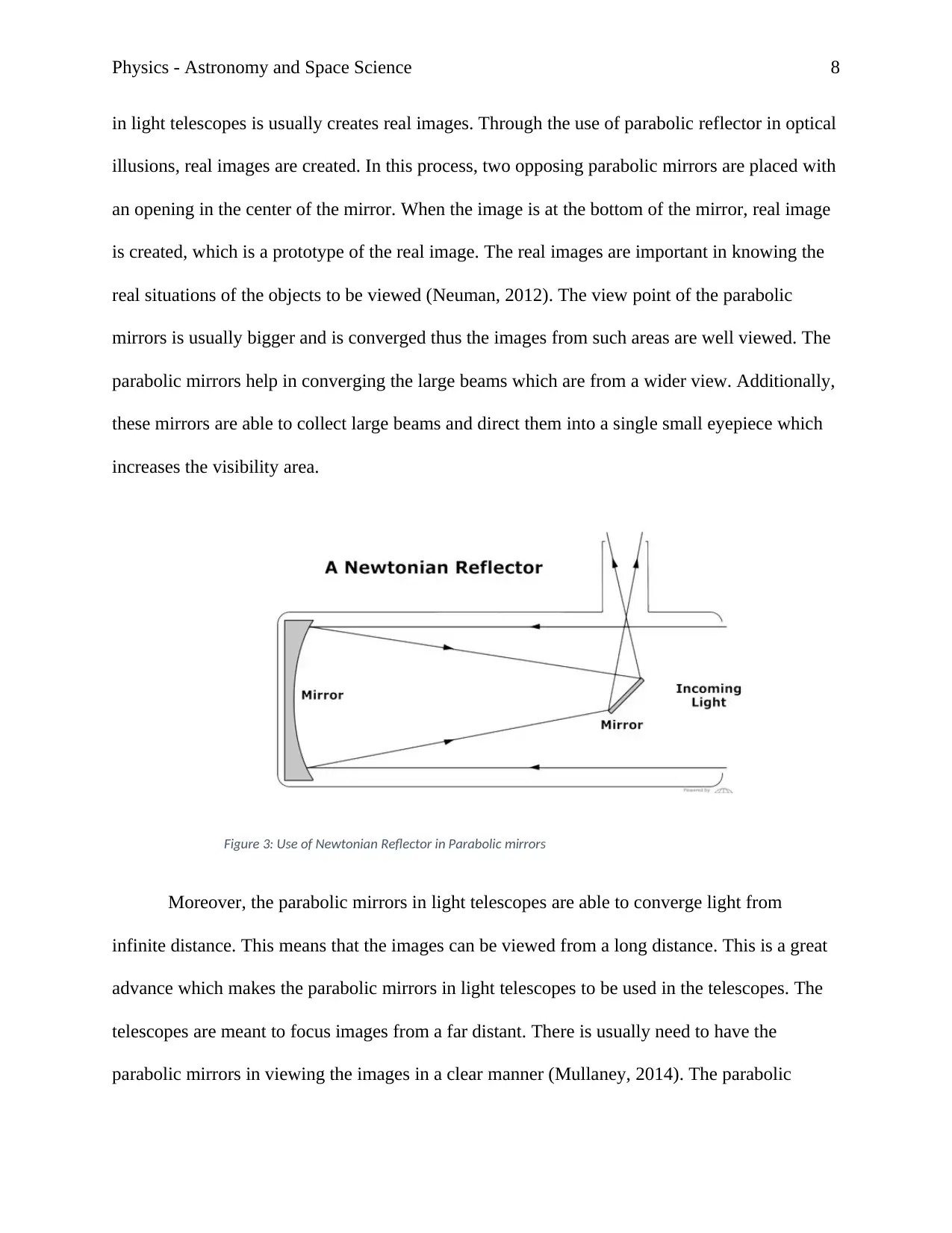
Physics - Astronomy and Space Science 8
in light telescopes is usually creates real images. Through the use of parabolic reflector in optical
illusions, real images are created. In this process, two opposing parabolic mirrors are placed with
an opening in the center of the mirror. When the image is at the bottom of the mirror, real image
is created, which is a prototype of the real image. The real images are important in knowing the
real situations of the objects to be viewed (Neuman, 2012). The view point of the parabolic
mirrors is usually bigger and is converged thus the images from such areas are well viewed. The
parabolic mirrors help in converging the large beams which are from a wider view. Additionally,
these mirrors are able to collect large beams and direct them into a single small eyepiece which
increases the visibility area.
Figure 3: Use of Newtonian Reflector in Parabolic mirrors
Moreover, the parabolic mirrors in light telescopes are able to converge light from
infinite distance. This means that the images can be viewed from a long distance. This is a great
advance which makes the parabolic mirrors in light telescopes to be used in the telescopes. The
telescopes are meant to focus images from a far distant. There is usually need to have the
parabolic mirrors in viewing the images in a clear manner (Mullaney, 2014). The parabolic
in light telescopes is usually creates real images. Through the use of parabolic reflector in optical
illusions, real images are created. In this process, two opposing parabolic mirrors are placed with
an opening in the center of the mirror. When the image is at the bottom of the mirror, real image
is created, which is a prototype of the real image. The real images are important in knowing the
real situations of the objects to be viewed (Neuman, 2012). The view point of the parabolic
mirrors is usually bigger and is converged thus the images from such areas are well viewed. The
parabolic mirrors help in converging the large beams which are from a wider view. Additionally,
these mirrors are able to collect large beams and direct them into a single small eyepiece which
increases the visibility area.
Figure 3: Use of Newtonian Reflector in Parabolic mirrors
Moreover, the parabolic mirrors in light telescopes are able to converge light from
infinite distance. This means that the images can be viewed from a long distance. This is a great
advance which makes the parabolic mirrors in light telescopes to be used in the telescopes. The
telescopes are meant to focus images from a far distant. There is usually need to have the
parabolic mirrors in viewing the images in a clear manner (Mullaney, 2014). The parabolic
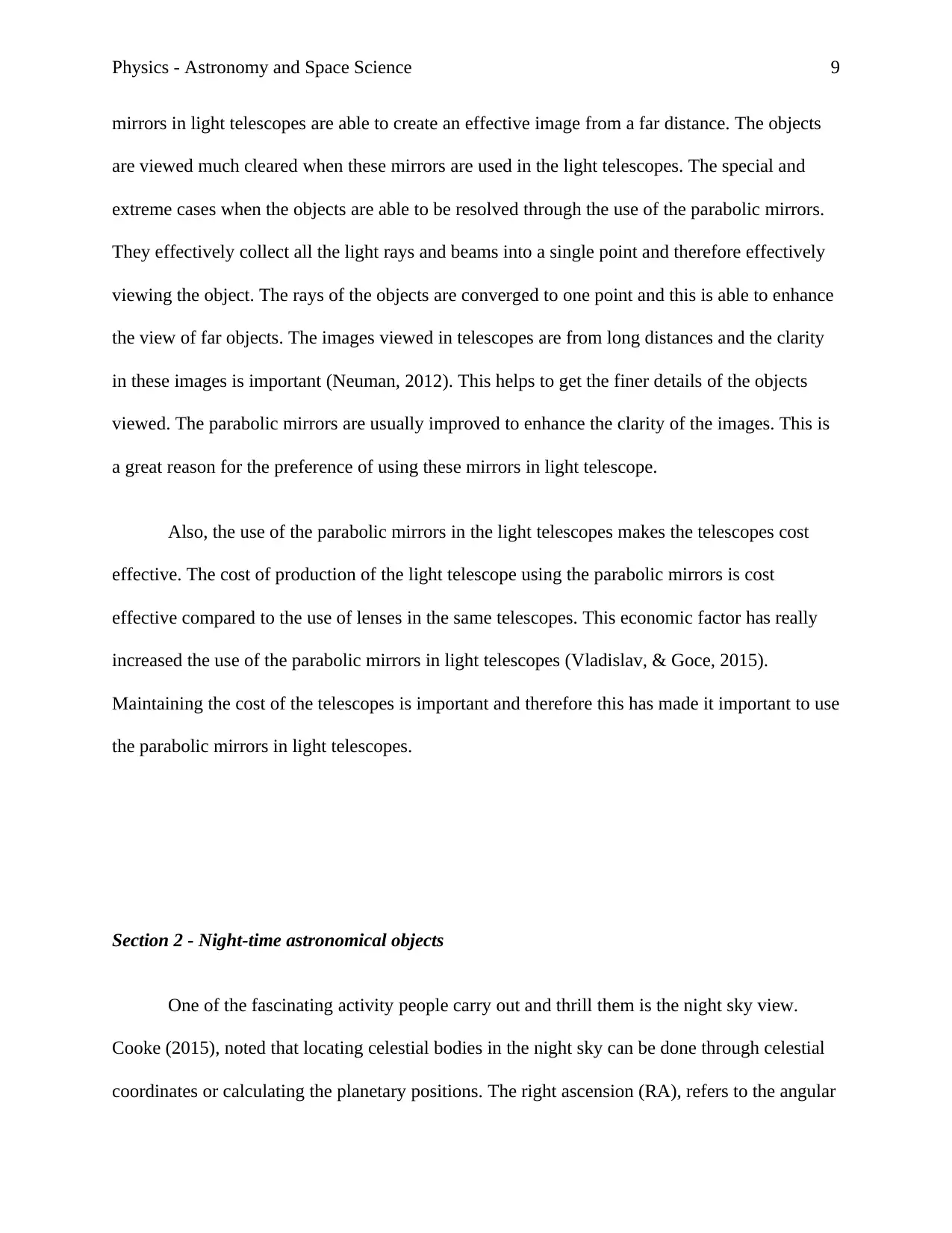
Physics - Astronomy and Space Science 9
mirrors in light telescopes are able to create an effective image from a far distance. The objects
are viewed much cleared when these mirrors are used in the light telescopes. The special and
extreme cases when the objects are able to be resolved through the use of the parabolic mirrors.
They effectively collect all the light rays and beams into a single point and therefore effectively
viewing the object. The rays of the objects are converged to one point and this is able to enhance
the view of far objects. The images viewed in telescopes are from long distances and the clarity
in these images is important (Neuman, 2012). This helps to get the finer details of the objects
viewed. The parabolic mirrors are usually improved to enhance the clarity of the images. This is
a great reason for the preference of using these mirrors in light telescope.
Also, the use of the parabolic mirrors in the light telescopes makes the telescopes cost
effective. The cost of production of the light telescope using the parabolic mirrors is cost
effective compared to the use of lenses in the same telescopes. This economic factor has really
increased the use of the parabolic mirrors in light telescopes (Vladislav, & Goce, 2015).
Maintaining the cost of the telescopes is important and therefore this has made it important to use
the parabolic mirrors in light telescopes.
Section 2 - Night-time astronomical objects
One of the fascinating activity people carry out and thrill them is the night sky view.
Cooke (2015), noted that locating celestial bodies in the night sky can be done through celestial
coordinates or calculating the planetary positions. The right ascension (RA), refers to the angular
mirrors in light telescopes are able to create an effective image from a far distance. The objects
are viewed much cleared when these mirrors are used in the light telescopes. The special and
extreme cases when the objects are able to be resolved through the use of the parabolic mirrors.
They effectively collect all the light rays and beams into a single point and therefore effectively
viewing the object. The rays of the objects are converged to one point and this is able to enhance
the view of far objects. The images viewed in telescopes are from long distances and the clarity
in these images is important (Neuman, 2012). This helps to get the finer details of the objects
viewed. The parabolic mirrors are usually improved to enhance the clarity of the images. This is
a great reason for the preference of using these mirrors in light telescope.
Also, the use of the parabolic mirrors in the light telescopes makes the telescopes cost
effective. The cost of production of the light telescope using the parabolic mirrors is cost
effective compared to the use of lenses in the same telescopes. This economic factor has really
increased the use of the parabolic mirrors in light telescopes (Vladislav, & Goce, 2015).
Maintaining the cost of the telescopes is important and therefore this has made it important to use
the parabolic mirrors in light telescopes.
Section 2 - Night-time astronomical objects
One of the fascinating activity people carry out and thrill them is the night sky view.
Cooke (2015), noted that locating celestial bodies in the night sky can be done through celestial
coordinates or calculating the planetary positions. The right ascension (RA), refers to the angular
⊘ This is a preview!⊘
Do you want full access?
Subscribe today to unlock all pages.

Trusted by 1+ million students worldwide
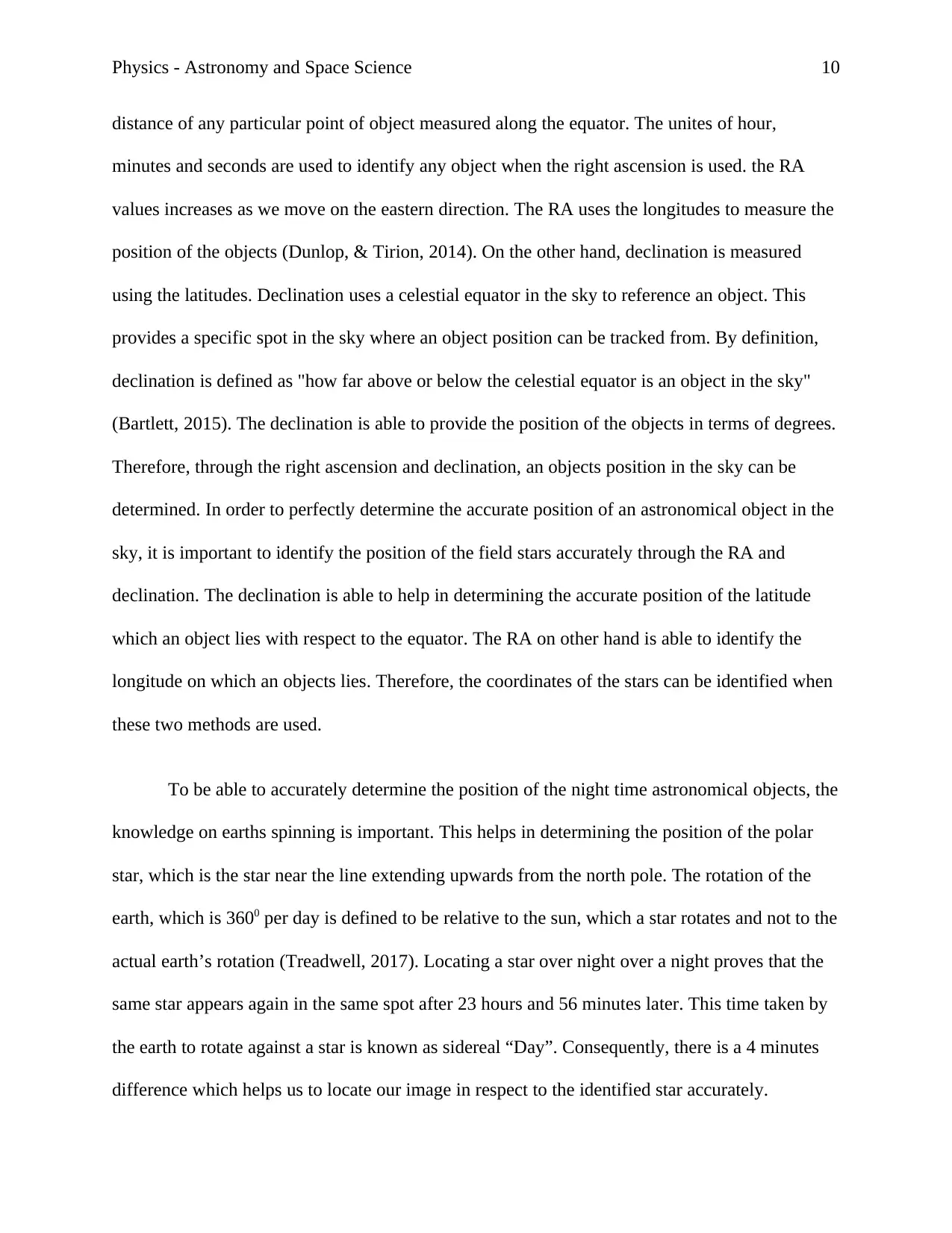
Physics - Astronomy and Space Science 10
distance of any particular point of object measured along the equator. The unites of hour,
minutes and seconds are used to identify any object when the right ascension is used. the RA
values increases as we move on the eastern direction. The RA uses the longitudes to measure the
position of the objects (Dunlop, & Tirion, 2014). On the other hand, declination is measured
using the latitudes. Declination uses a celestial equator in the sky to reference an object. This
provides a specific spot in the sky where an object position can be tracked from. By definition,
declination is defined as "how far above or below the celestial equator is an object in the sky"
(Bartlett, 2015). The declination is able to provide the position of the objects in terms of degrees.
Therefore, through the right ascension and declination, an objects position in the sky can be
determined. In order to perfectly determine the accurate position of an astronomical object in the
sky, it is important to identify the position of the field stars accurately through the RA and
declination. The declination is able to help in determining the accurate position of the latitude
which an object lies with respect to the equator. The RA on other hand is able to identify the
longitude on which an objects lies. Therefore, the coordinates of the stars can be identified when
these two methods are used.
To be able to accurately determine the position of the night time astronomical objects, the
knowledge on earths spinning is important. This helps in determining the position of the polar
star, which is the star near the line extending upwards from the north pole. The rotation of the
earth, which is 3600 per day is defined to be relative to the sun, which a star rotates and not to the
actual earth’s rotation (Treadwell, 2017). Locating a star over night over a night proves that the
same star appears again in the same spot after 23 hours and 56 minutes later. This time taken by
the earth to rotate against a star is known as sidereal “Day”. Consequently, there is a 4 minutes
difference which helps us to locate our image in respect to the identified star accurately.
distance of any particular point of object measured along the equator. The unites of hour,
minutes and seconds are used to identify any object when the right ascension is used. the RA
values increases as we move on the eastern direction. The RA uses the longitudes to measure the
position of the objects (Dunlop, & Tirion, 2014). On the other hand, declination is measured
using the latitudes. Declination uses a celestial equator in the sky to reference an object. This
provides a specific spot in the sky where an object position can be tracked from. By definition,
declination is defined as "how far above or below the celestial equator is an object in the sky"
(Bartlett, 2015). The declination is able to provide the position of the objects in terms of degrees.
Therefore, through the right ascension and declination, an objects position in the sky can be
determined. In order to perfectly determine the accurate position of an astronomical object in the
sky, it is important to identify the position of the field stars accurately through the RA and
declination. The declination is able to help in determining the accurate position of the latitude
which an object lies with respect to the equator. The RA on other hand is able to identify the
longitude on which an objects lies. Therefore, the coordinates of the stars can be identified when
these two methods are used.
To be able to accurately determine the position of the night time astronomical objects, the
knowledge on earths spinning is important. This helps in determining the position of the polar
star, which is the star near the line extending upwards from the north pole. The rotation of the
earth, which is 3600 per day is defined to be relative to the sun, which a star rotates and not to the
actual earth’s rotation (Treadwell, 2017). Locating a star over night over a night proves that the
same star appears again in the same spot after 23 hours and 56 minutes later. This time taken by
the earth to rotate against a star is known as sidereal “Day”. Consequently, there is a 4 minutes
difference which helps us to locate our image in respect to the identified star accurately.
Paraphrase This Document
Need a fresh take? Get an instant paraphrase of this document with our AI Paraphraser
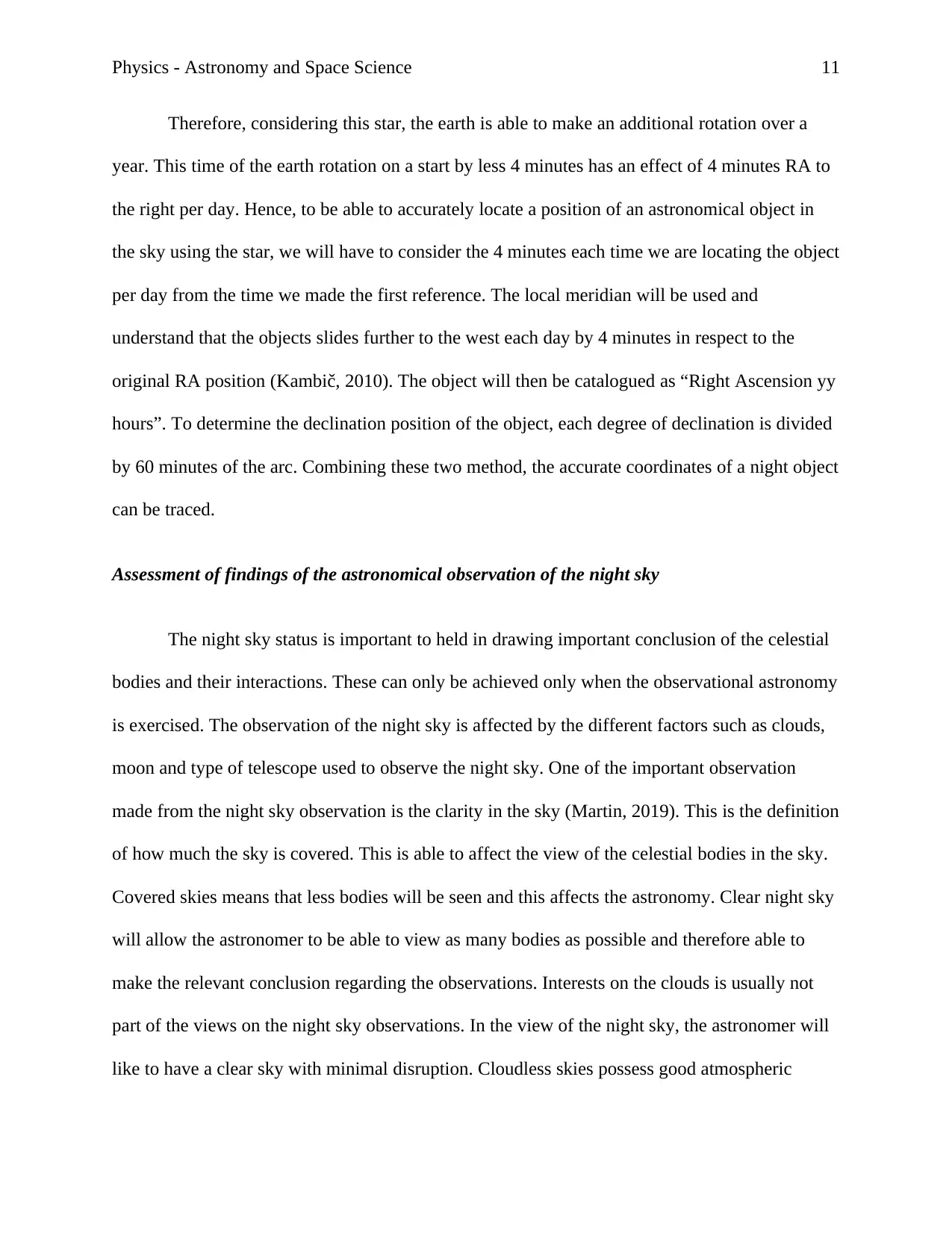
Physics - Astronomy and Space Science 11
Therefore, considering this star, the earth is able to make an additional rotation over a
year. This time of the earth rotation on a start by less 4 minutes has an effect of 4 minutes RA to
the right per day. Hence, to be able to accurately locate a position of an astronomical object in
the sky using the star, we will have to consider the 4 minutes each time we are locating the object
per day from the time we made the first reference. The local meridian will be used and
understand that the objects slides further to the west each day by 4 minutes in respect to the
original RA position (Kambič, 2010 ). The object will then be catalogued as “Right Ascension yy
hours”. To determine the declination position of the object, each degree of declination is divided
by 60 minutes of the arc. Combining these two method, the accurate coordinates of a night object
can be traced.
Assessment of findings of the astronomical observation of the night sky
The night sky status is important to held in drawing important conclusion of the celestial
bodies and their interactions. These can only be achieved only when the observational astronomy
is exercised. The observation of the night sky is affected by the different factors such as clouds,
moon and type of telescope used to observe the night sky. One of the important observation
made from the night sky observation is the clarity in the sky (Martin, 2019). This is the definition
of how much the sky is covered. This is able to affect the view of the celestial bodies in the sky.
Covered skies means that less bodies will be seen and this affects the astronomy. Clear night sky
will allow the astronomer to be able to view as many bodies as possible and therefore able to
make the relevant conclusion regarding the observations. Interests on the clouds is usually not
part of the views on the night sky observations. In the view of the night sky, the astronomer will
like to have a clear sky with minimal disruption. Cloudless skies possess good atmospheric
Therefore, considering this star, the earth is able to make an additional rotation over a
year. This time of the earth rotation on a start by less 4 minutes has an effect of 4 minutes RA to
the right per day. Hence, to be able to accurately locate a position of an astronomical object in
the sky using the star, we will have to consider the 4 minutes each time we are locating the object
per day from the time we made the first reference. The local meridian will be used and
understand that the objects slides further to the west each day by 4 minutes in respect to the
original RA position (Kambič, 2010 ). The object will then be catalogued as “Right Ascension yy
hours”. To determine the declination position of the object, each degree of declination is divided
by 60 minutes of the arc. Combining these two method, the accurate coordinates of a night object
can be traced.
Assessment of findings of the astronomical observation of the night sky
The night sky status is important to held in drawing important conclusion of the celestial
bodies and their interactions. These can only be achieved only when the observational astronomy
is exercised. The observation of the night sky is affected by the different factors such as clouds,
moon and type of telescope used to observe the night sky. One of the important observation
made from the night sky observation is the clarity in the sky (Martin, 2019). This is the definition
of how much the sky is covered. This is able to affect the view of the celestial bodies in the sky.
Covered skies means that less bodies will be seen and this affects the astronomy. Clear night sky
will allow the astronomer to be able to view as many bodies as possible and therefore able to
make the relevant conclusion regarding the observations. Interests on the clouds is usually not
part of the views on the night sky observations. In the view of the night sky, the astronomer will
like to have a clear sky with minimal disruption. Cloudless skies possess good atmospheric
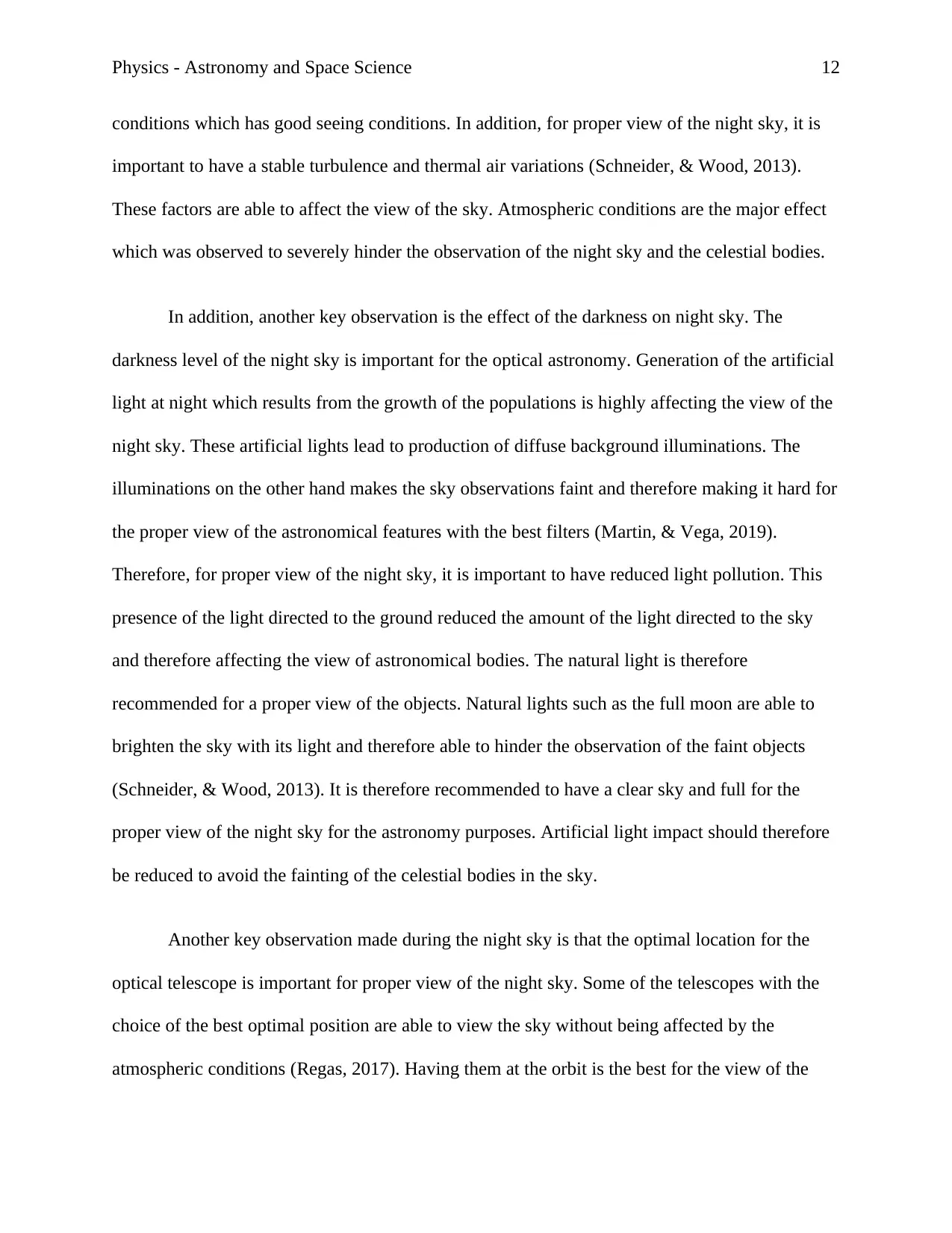
Physics - Astronomy and Space Science 12
conditions which has good seeing conditions. In addition, for proper view of the night sky, it is
important to have a stable turbulence and thermal air variations (Schneider, & Wood, 2013).
These factors are able to affect the view of the sky. Atmospheric conditions are the major effect
which was observed to severely hinder the observation of the night sky and the celestial bodies.
In addition, another key observation is the effect of the darkness on night sky. The
darkness level of the night sky is important for the optical astronomy. Generation of the artificial
light at night which results from the growth of the populations is highly affecting the view of the
night sky. These artificial lights lead to production of diffuse background illuminations. The
illuminations on the other hand makes the sky observations faint and therefore making it hard for
the proper view of the astronomical features with the best filters (Martin, & Vega, 2019).
Therefore, for proper view of the night sky, it is important to have reduced light pollution. This
presence of the light directed to the ground reduced the amount of the light directed to the sky
and therefore affecting the view of astronomical bodies. The natural light is therefore
recommended for a proper view of the objects. Natural lights such as the full moon are able to
brighten the sky with its light and therefore able to hinder the observation of the faint objects
(Schneider, & Wood, 2013). It is therefore recommended to have a clear sky and full for the
proper view of the night sky for the astronomy purposes. Artificial light impact should therefore
be reduced to avoid the fainting of the celestial bodies in the sky.
Another key observation made during the night sky is that the optimal location for the
optical telescope is important for proper view of the night sky. Some of the telescopes with the
choice of the best optimal position are able to view the sky without being affected by the
atmospheric conditions (Regas, 2017). Having them at the orbit is the best for the view of the
conditions which has good seeing conditions. In addition, for proper view of the night sky, it is
important to have a stable turbulence and thermal air variations (Schneider, & Wood, 2013).
These factors are able to affect the view of the sky. Atmospheric conditions are the major effect
which was observed to severely hinder the observation of the night sky and the celestial bodies.
In addition, another key observation is the effect of the darkness on night sky. The
darkness level of the night sky is important for the optical astronomy. Generation of the artificial
light at night which results from the growth of the populations is highly affecting the view of the
night sky. These artificial lights lead to production of diffuse background illuminations. The
illuminations on the other hand makes the sky observations faint and therefore making it hard for
the proper view of the astronomical features with the best filters (Martin, & Vega, 2019).
Therefore, for proper view of the night sky, it is important to have reduced light pollution. This
presence of the light directed to the ground reduced the amount of the light directed to the sky
and therefore affecting the view of astronomical bodies. The natural light is therefore
recommended for a proper view of the objects. Natural lights such as the full moon are able to
brighten the sky with its light and therefore able to hinder the observation of the faint objects
(Schneider, & Wood, 2013). It is therefore recommended to have a clear sky and full for the
proper view of the night sky for the astronomy purposes. Artificial light impact should therefore
be reduced to avoid the fainting of the celestial bodies in the sky.
Another key observation made during the night sky is that the optimal location for the
optical telescope is important for proper view of the night sky. Some of the telescopes with the
choice of the best optimal position are able to view the sky without being affected by the
atmospheric conditions (Regas, 2017). Having them at the orbit is the best for the view of the
⊘ This is a preview!⊘
Do you want full access?
Subscribe today to unlock all pages.

Trusted by 1+ million students worldwide
1 out of 19